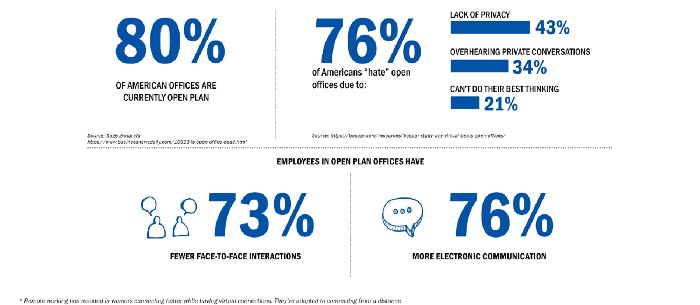
A penthouse conference space is surrounded by rooftop gardens and gathering areas at the Flatiron Institute
in New York. Photograph Copyright Chris Cooper / Courtesy Perkins Eastman
The global health crisis presents a unique opportunity to re-imagine and redefine the future of the office — to reshape its role in our economy, culture, and health—for years to come.
Our Design Strategy and Workplace practices have been collaborating with our clients, consultants, and staff to explore and define the workplace paradigm shift that is upon us. We’ve documented the individual and organizational effects of COVID-19 through a variety of methods, including hosting virtual roundtable discussions with more than 40 industry leaders from construction to law, healthcare to technology; distributing a firm-wide employee survey to gain first-hand insight from our own staff, and conducting in-depth research to understand COVID-19’s impact at practical, emotional, and psychological levels.
The summation of this work, our Work/Life Re-imagined Highlights report, identifies key trends, opportunities, and forecasting related to the future of work and workplace design.
Our findings reveal a collective shift in attitudes towards remote work, the role of technology, and expectations around health, safety, and well-being in the workplace.
We ask: How do companies maintain corporate culture with a partial remote workforce? If the “home office” is here to stay, what does the new office look like? With the success of working from anywhere, is the office still relevant?
The office suffered an immediate blow from COVID-19 as the majority of workers were pushed into the world’s largest work-from-home experiment. By one estimate, 16 million knowledge workers in the United States were forced into remote work by late March as a result of the pandemic — a number that has likely increased in the past months.
But the workplace was ripe for change long before COVID-19 turned the world on its head.
The open office floor plan has many merits, especially for creative and collaborative work. However, many workers dislike the open floor plan, complaining of a lack of privacy and the inability to concentrate. In spite of evidence that the majority of these workers dislike open offices, it is estimated that 80% of businesses in the United States currently use this model. With the risk of COVID-19 transmission heightened in close proximity, open plans are less ideal for office reentry. Common complaints include lack of privacy and the inability to concentrate. In addition, open offices are associated with increased stress, decreased productivity, and lower job satisfaction, among other unfavorable outcomes. Concerns about the spread of a deadly airborne virus only add to the list of grievances.

While open offices are often associated with increased stress, decreased productivity, and lower job satisfaction, remote working is proving a far more successful experiment. Employees have become adept at using technology to stay connected and manage their workflow. They benefit from time saved on commuting to the office, fewer distractions, being able to focus on heads-down work, and the ability to tailor their schedules around personal commitments.
Not surprisingly, after months of being un-tethered from the office, there is a strong desire to maintain the flexibility and convenience of working remotely even when it is safe to return.

The workplace employees return to will be very different than the one they left behind.
Our survey indicated that overwhelmingly, while people enjoy working from home, they don’t want to work remotely full time. Therefore the new office must accommodate the new needs of a remote workforce; it must adapt to our New Normal.

Currently, Perkins Eastman is working with varying industries to adapt and evolve their workplaces.We are working with one organization, for example, to explore the feasibility of a decentralized office model with satellite sites and a community hub. By decreasing their footprint dramatically and centering their workforce in a “showroom office” for both clients and staff, this client’s new workplace becomes a communal destination, a blended environment to connect with their various satellite offices, and a healthy harbor to ensure employee safety and mental well-being.
The role of the office is shifting. COVID-19 has magnified and resurfaced longstanding problems with our previous work/life routines.
But to evolve existing models, we need to adopt new ways of thinking. We have an opportunity to meet the new needs of employees; to cultivate creativity, to promote collaboration.
Designing along these three design pillars: communal destination, blended environment, and healthy harbor, what might this new office look like? What pioneering designs can we provide to meet the evolving New Normal?